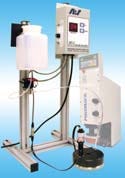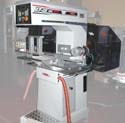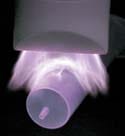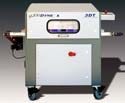July 16, 2004
Originally Published MPMN July 2004
SPOTLIGHT
Printing and Surface Treatment
Viscosity controller
A viscosity controller continuously monitors the ink inside a sealed ink cup within pad printers. If the viscosity varies outside a preset range, solvent is automatically addedto bring the ink back to its proper setting without operator intervention or production interruption. The VC-1 can be retrofitted to most sealed-cup pad printers. It is mounted directly in the ink cup,eliminating the need for off-printer ink reservoirs. The product works with single- or two-component inks.Automated Industrial Systems, Erie, PA www.padmark.com
Drug-eluting surface coating
Coating technology provides a polymeric matrix on the surface of medical devices or as part of a drug-delivery device for use as a reservoir. Therapeutic or antimicrobial agents can then be released from the matrix at a controlled rate. The company's drug-eluting coating delivers a variety of pharmaceutical agents for durations ranging from minutes to months.SurModics Inc., Eden Prairie, MN www.surmodics.com
Programmable pad printer
A distributor of surface treatment equipment prints depth-mark bands 360° around tubing. Programmable pad printers make it possible for various artwork to be placed on one print plate. By entering different settings, the user can work on jobs with varying diameter sizes without any manual adjustments. Automatic pad-cleaning systems are also offered on most models.
Pad Print Machinery of Vermont, East Dorset, VT www.padprint1.com
Air plasma surface treater
A 3-D air plasma surface treater generates a blown arc discharge suitable for high speeds and demanding applications. The Dyne-A-Mite HP improves surface adhesion for printing, painting, coating, bonding, and labeling applications. With the ability to create clear readable markings, the equipment can treat polyethylene, polypropylene, polyethyleneterephthalate, polymethylmethacrylate, PVC, and other thermoformed and thermoset plastics. Operator-guided front-panel controls feature start- and stop-treatment buttons.Enercon Industries Corp., Menomonee Falls, WI www.enerconind.com
Corona treating system
Many 3-D plastic parts can be handled by a compact, self-contained Corona treating system. According to the company, FlexiDyne enhances pad printing, bonding, coating, and tissue-culture growth. Different sizes and shapes can be treated without changing the setup. Nonmetallic items that fit through the machine's150 ¥ 30-mm opening can receive uniform Corona treating on all exposed areas. The FlexiDyne systemscan be operated as stand-alone workstations or integrated into existing or new production lines.
3DT, Germantown, WI www.3dtllc.com
Thermal transfer printer
A thermal transfer digital printer is suitable for marking porous surfaces directly on the production line. The Coditherm process marks and codes paper, bags, and containers, as well as rubber, fabrics, and scratch-proof and solvent-resistant plastic. The equipment uses a double ribbon to create a positive image electronically on the inked thermal ribbon in an initial print phase. The image is then transferred to the designated surface. Print speed is approximately 1 c/sec depending on the messagesize, with a maximum marking area of 3.74 ¥ 8.66 in. Matthews InternationalCorp., Pittsburgh, PA www.matthewsmarking.com
Parylene coating
The construction of a 1700-sq-ft cleanroom added Class 10,000, Class 1000, and Class 100 areas for part fixturing and examination as part of a company's coating capabilities. The facility allows incoming products to be received into a filtered environment, parylene coated, examined, and repacked for shipment. Laminar-flow air-handling and HEPA filtering, gowning, and masking help to control the bioburden, which minimizes the required sterilization doses prior to medical use. The controlled environment includes the company'sPDS 2035CR parylene deposition system for fully automated cleaning and device loading and unloading.Specialty Coating Systems, Indianapolis, IN www.scscookson.com
Gas plasma surface modification
Designed for continuous treatment of membrane, film, fabric, web, and foil, a low-pressure gas plasma system offers surface modification, ultrapure cleaning, and coating. Typical applications for the V160-RT system include increasing wettability or bondability, attaching chemical functional groups for surface receptivity, or cleaning to remove organic contamination. In addition, an optional thin-film coating permits deposition of polymerized thin-film coatings. Microprocessor control, stored recipes, mass-flow controllers, and operator lockout guarantee consistent processing. A variable speed winding and rewinding mechanism permits
in situ multistep processing of rolls with up to 12 ¥ 16-in. diameters. PlasmatechInc., Erlanger, KY www.plasmatechnology.com
Plasma bonding technology
Environmentally friendly technology enables plasma to be used in the atmosphere for surface treatment. Designed to replace vacuum plasma and batch processing, the Flume technology is mainly used to microclean and activate the surface of materials like polypropylene, polyethylene, polycarbonate, silicone, glass, and ceramics. The results include adhesive joining, coating, printing, and overmolding. It also enables two-shot injection moldingof dissimilar materials like polycarbonate and silicone. Settings are adjustable to application needs, and all process parameters are monitored. Current applications include bonding membranes within oxygenators, bonding catheters and needles to polypropylene hubs, cleaning glass, and hydrophilizing test strips within metallic inserts.PlasmaTreat North America Inc., Mississauga, ON, Canada www.plasmatreat.com
Pad-printing machines
|
Using a programmable logic controller touch screen panel, a series of pad-printing machines can be adjusted to variable heights for ink pick-up, delivery, and pad cleaning within the same cycle. The servo-driven X3 series uses three servomotors, enabling high, repeatable positional accuracy for tight tolerances. Betweenthe plate holder, which controls the x- and rotation axes, and the pad stroke's horizontal and vertical motion, movement on all axes is allowed without additional adjustment devices. A pad-cleaning device is integrated into the design and can be added or removed. The machines are available in both open-well and sealed-cup
inking systems. Teca-Print USA Corp., Billerica, MA www.tecaprint.com
Copyright ©2004 Medical Product Manufacturing News
You May Also Like


